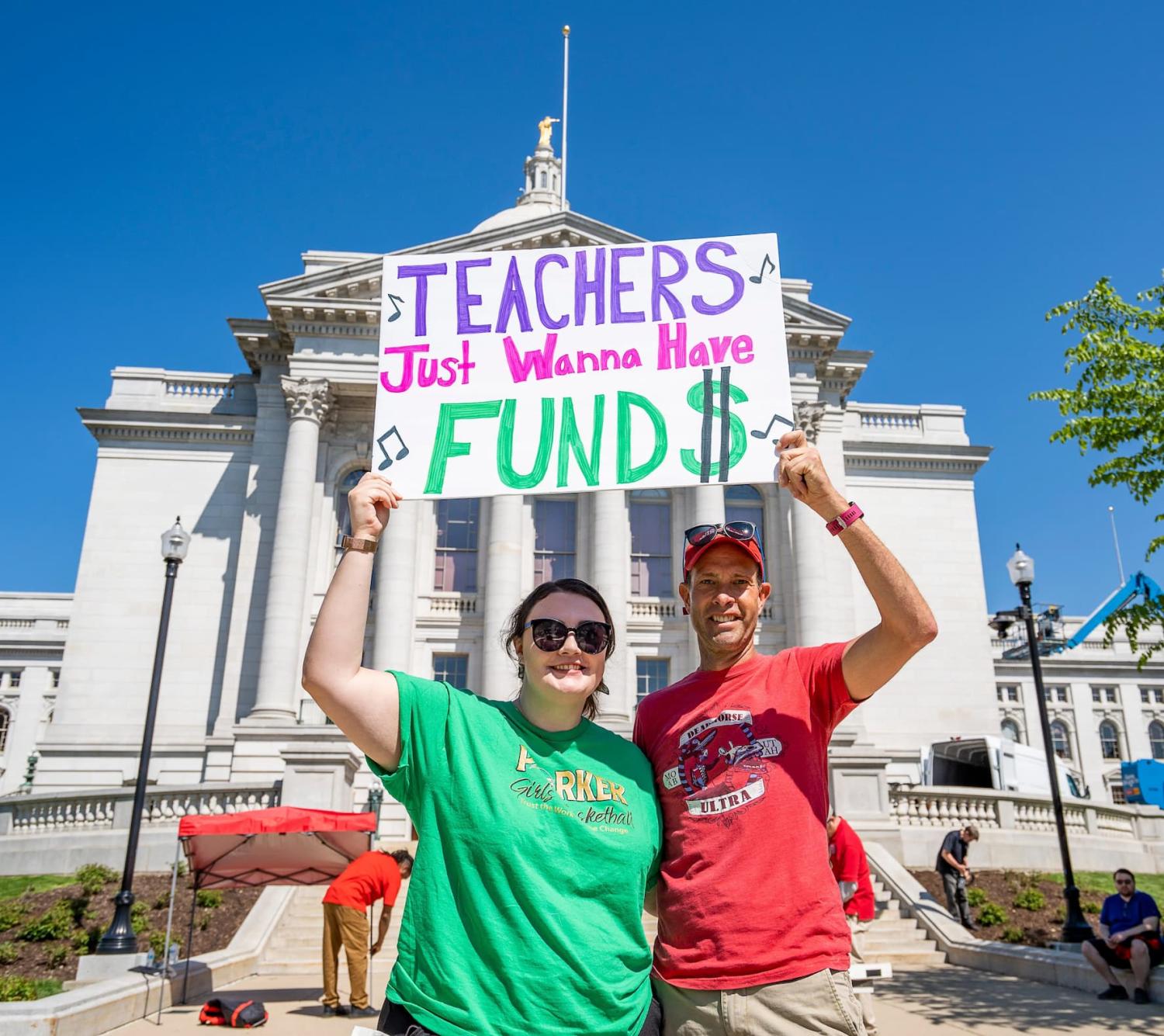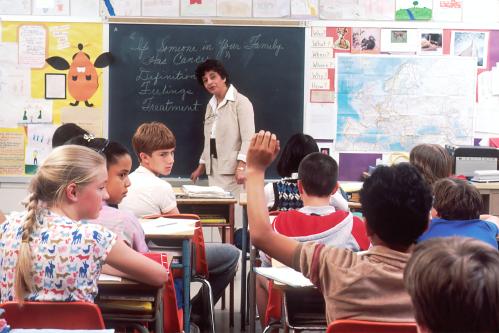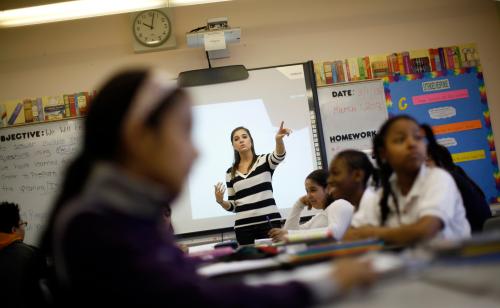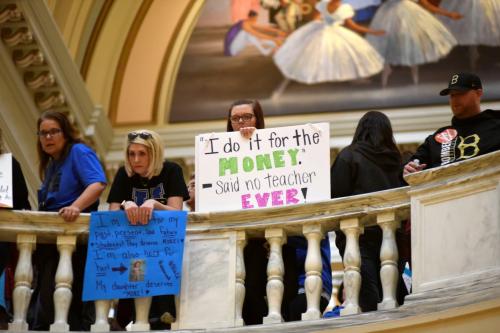Pensions are an important component of total compensation for most employees but particularly for public school teachers. Teachers tend to have relatively low salaries but retirement benefits that are considerably more generous than in a typical private-sector 401(k) plan. Yet the risk facing teachers is that many teacher pension plans are significantly underfunded, placing their employers under considerable financial strain, and reducing resources available for schools and for teacher pay and benefits. The funding shortfalls facing teacher pensions today stems from a long but increasing overreliance on the stock market to pay high annual returns. Unfortunately, to dig themselves out of their funding hole, many teacher pensions have doubled down on investment risk. While teacher pensions weathered the COVID-19 pandemic better than many had expected, significant funding challenges remain to be addressed. And the retirement security of America’s four million public school teachers depends upon these efforts being successful.
In an article published in the journal Education Researcher, I examined the funding of 27 teacher retirement systems from 2001 through 2019, using data drawn from the Public Plans Database, and looked to what the financial travails of many teacher pensions could mean for the future. In 2001, the median teacher retirement system was 96% funded, buoyed by the tech bubble in the stock market. But in 2001 the tech bubble melted down, and then in 2008 the housing market melted down and triggered the Great Recession. By 2019, the median teacher pension was only 70% funded.
One flaw that most economists see in teacher and other public employee pensions is the funding rules these plans follow. State and local government pensions, including teacher plans, effectively credit themselves with the higher returns paid by risky investments like stocks before those risks have paid off. That is to say, the amounts governments contribute each year assume that those contributions will earn 7% to 8% interest in following years. Private sector pensions, by contrast, are required under federal law to assume lower discount rates based on corporate bond yields. This doesn’t mean that private pensions can’t invest in stocks. They can and do. But they cannot credit themselves with the higher expected returns paid by stock and other risky investments before those risks pay off. Consequently, the federal rules for private pensions require higher contributions upfront to maintain solvency and have resulted in a much stronger funding base over time. The typical private pension plan has put aside roughly twice as much in assets to pay each dollar of promised benefits than have teacher pension plans. While public and private pension funding rules in the U.S. evolved differently, mostly for historical reasons, most economists see no reason pensions in the two sectors should be governed differently, and in many other countries there is no distinction between public and private sector plans.
The reason teacher pension funding has suffered so much over the past two decades is that teacher pension plans overestimated the rate of return they would receive on their investment. In 2001, the median teacher plan assumed a future nominal investment return of 8.0%, ranging from a low of 7.3% to a high of 8.8%. But the median teacher plan received an average annual investment return from 2001 through 2019 that was 1.4 percentage points below the return it had assumed in 2001. The smallest gap between assumed and actual returns was a -0.2% shortfall for the Oklahoma Teachers program while the largest gap was for the New Jersey Teachers plan, which assumed 8.8% future returns in 2001 but received only 5.8% from 2001 through 2018. Not a single teacher plan actually underestimated their investment returns from 2001 to 2019. Pension liabilities tend to increase by about one fifth for each percentage point change in the discount rate applied to those liabilities. For many teacher pensions, over-optimism regarding future investment returns played the major role in the unfunded liabilities those plans face today.
And yet many teacher pensions have responded to today’s underfunding by taking additional risk with their investments, hoping that higher returns in the future will make up for past shortfalls. The median teacher pension plan in 2001 held 65% of its investments in risky assets, which include stocks, private equity, hedge funds, other alternative investments, commodities, and real estate. By 2019, the median teacher plan held 76% of its investments in risky assets.
But this increased risk-taking is happening against a backdrop in which teacher pensions are less able to weather a stock market downturn. Teacher pensions are growing more “mature,” meaning that these plans have relatively larger numbers of retirees and fewer active workers. By my calculations, in 2001 the median teacher retirement system had 2.3 active employees for each retiree. By 2019, there were only 1.3 employees per retiree. A pension plan with more retirees must pay out larger amounts each month, leaving less room for error in riding out the inevitable investment downturns.
But with annual pension contributions by schools and teachers already having risen by 70% since 2001, pension administrators may wonder how much more they can demand. Schools must pay for buildings, books, and yes, teacher salaries—not merely fund pension benefits for already-retired teachers.
Teachers and education policymakers may wish to consider more far-reaching changes. The reality is that, even as many teachers complain of low salaries, their compensation package may be overweighted toward retirement benefits—not just pensions, which are typically far more generous than private sector workers receive, but also retiree health benefits. The National Income and Product Accounts, which are compiled by the federal government, show that the average employee in public education receives fringe benefits, both present and future, that are equal to 51% of their salaries. A typical private sector worker, by contrast, receives benefits equal to only around 20% of their salary. The problem is that most employees look first at the salary offered in a job position, with pensions playing a less important role. Recalibrating teachers’ retirement packages could free up funds to increase teacher salaries, particularly starting salaries that often are deemed unattractive.
While the COVID-19 pandemic hit teacher pensions with a stock market downturn in early 2020, markets largely recovered thereafter. Moreover, generous federal government aid to state and local governments allowed states like Connecticut, Ohio, and New Jersey to make unusually large pension contributions in recent years. However, as federal aid wanes, the demographic and financial realities facing teacher pension systems will reassert themselves, and both school administrators and teachers themselves may feel the financial pinch.
Any change to teacher pensions is controversial. But teachers and public education could benefit from gradually transitioning from traditional pensions that rely excessively on risky investments to a more sustainable and affordable model that frees up resources for improved teacher salaries.
The Brookings Institution is committed to quality, independence, and impact.
We are supported by a diverse array of funders. In line with our values and policies, each Brookings publication represents the sole views of its author(s).







